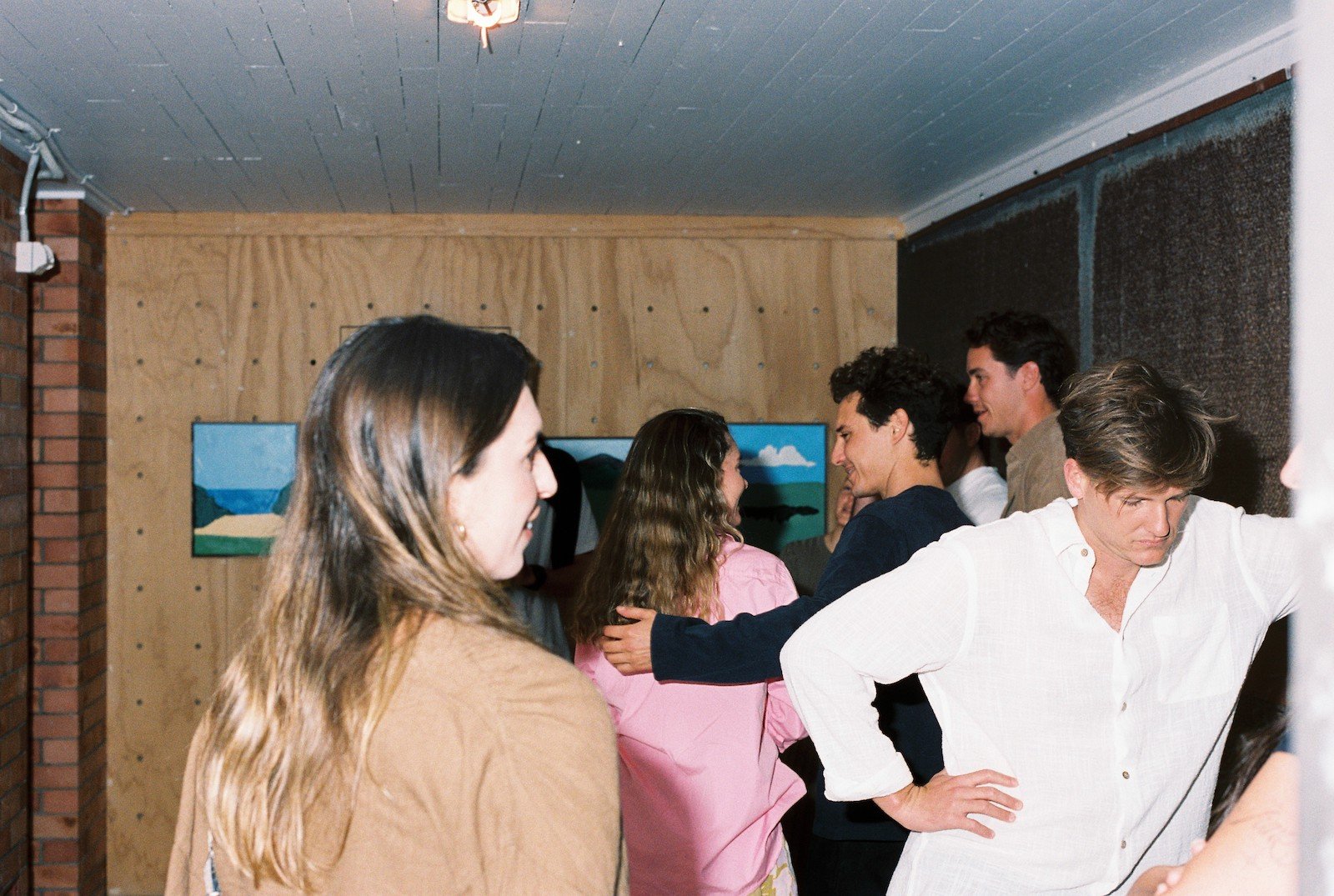Arriving at the opening of WARP—Jack MacRae’s solo exhibition presented by Horizon Festival—the scratching of sand in my shoes couldn’t feel more suitable. Having grown up with a surfing family in this area, MacRae’s minimal frames of Sunshine Coast beach scenes are welcoming and nostalgic. They capture the headlands, bays and landmarks that define the region. Salty locks and zinced noses throughout the gallery’s crowd further illustrate how intertwined this work is with local beach culture, with audiences pointing out their favourite spots and views.
MacRae is quickly becoming a staple artist of the Sunshine Coast, garnering a solid following of commission-thirsty admirers and leading the branding design of this year’s Horizon Festival. A bodysurfer by morning and draftsperson by day, MacRae’s art practice provides a meditative and playful escape from the rigidity of architecture as well as an avenue for exploring natural forms and palettes shaped by the ocean. Initially working with paper collage techniques to construct formalist landscapes, Mcrae’s more recent move to oils is forefronted in this exhibition. With oils come new textures and details, saturated brush strokes caress and bubbles of paint ripple across the canvas like whitewash on tidal sands.
Colour forms the loose narrative of the exhibition with MacRae capturing the breadth of tones that colour the landscape over the course of a clear day. Across three rooms we encounter: the warm yellow of sunrise, the deep blues of a scorching summer day and the pink reprisal of dusk, and finally the dramatic contrasts of radiant orange and cold navy as the sun tantalises dark hills on the horizon. Select explorations of muted, overcast hues and pastel combinations adorn the works, though MacRae’s reliance on a true yellow and his use of near-black for shadow work feels like a missed opportunity for nuance.
Despite the artist’s formally reductivist approach to depth, his scenes are filled to the brim with space. Delicate inclusions of single clouds and their shadows further explore levitation, stasis, and stillness. I can almost hear the subtle sounds of cicadas and beach brush shifting in the wind. Scenes of landmarks and surf breaks call up scenes imprinted in my memory as a child in the passenger seat of surf expeditions. I’m taken back to Mt. Coolum, basking in sunlight, or spotting hollow waves rolling through Second Bay, and astonished at the pristine natural environment.
MacRae’s heritage as a bodysurfer is obvious in these works. His vacant seasides and green masses sliding towards the ocean often depict views from the perspective of the waves while a veneer of vision-blurring salt water creates opaque skies and liquid beaches. Are we seeing what Jack sees? Are we feeling the soft flow of the ocean against his skin? Taking ample time to contemplate the work, the experience is peacefully visceral. The pieces are playful, bubbly and textured, almost reminiscent of fellow Coast based painter Mitchell English but without the populace. Rather than picturing passive views of beachgoers, MacRae brings us into his life, one of sneaking to the seaside while the world is at work, of languid landscapes and the quietude of having the ocean to oneself.
A man with a sun-beaten nose pushes past me, muttering “I could have done this…” His critique pulls me out of MacRae’s landscapes and back to the surface of his canvases, where a technique with oils is clearly still developing. Subtle imperfections and misplaced drops risk tipping the playfulness of the exhibition towards carelessness, though in the jovial atmosphere of the evening they’re easily forgiven. The hero works of the exhibition, Fairy Pools and Yaroomba are the most technical and they are especially captivating. An intimate view from a rocky beach nook, Fairy Pools depicts a vertical slice of distant composition bordered by shadowed rocky walls, with sand, hills, and sky stepping out into the distance. The viewing experience is tactile—I can feel the coolness of the rocks against the glare of the sun, taste the crystallised salt around my lips, and relish the shaded repose of hidden beach canyons everywhere.
The exhibition is housed in the Old Lock-Up, a 1980s relic of a watch house that held locals overnight during some of Queensland’s most brutal decades. The three rooms of the exhibition are three cells, each with a concrete bench, toilet, and countless messages scratched into their walls: names, warnings, and laments from generations of cellmates. Against these imposing spaces, MacRae’s canvases are windows to an idyllic conception of the Sunshine Coast; a bright, vibrant and pristine region baked by the tropics and cooled by the surf. Evidence of the area’s underbelly in such close proximity creates an intriguing contrast, helping to fill the void of cultural commentary left by the formalist tradition. The combination also reminds me of Joe Strummer’s (of The Clash) reported visit to Sydney in the 1980s. It’s said that Joe took one look at the beaches, felt the sunlight, saw the great expanse of scantily clad swimmers along Bondi beach and said “Well how are you supposed to have punk here?” The Sunshine Coast is a storied place with a wealth of history and perspectives. As a tribute to the stunning natural forms that anchor the area’s culture, MacRae’s exhibition is a captivating and playful insight into a peaceful life in their shadow.
This review was kindly sponsored by Briony Barr. Barr’s solo exhibition, Drawing on the Pause, is currently on at Pop Gallery, Fortitude Valley, 5–16 September. Opening event 6-8pm Friday 8 September featuring live drawing and musicians.
Fin Wegener is an audiovisual artist and writer working between Brisbane and the Sunshine Coast. Building from a background in music, Fin is passionate about experimental practices and experiential mediums across forms.







